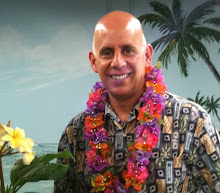The Hawaiian language is much deeper than 13 letters and a series of words (all seemingly with a vowel-to-consonant ratio of 4:1!) As I've explored the meaning of Aloha Leadership, it's become apparent to this haole (Mainlander) that to understand Hawaiian culture one has to put aside some preconceptions.
1. One size fits all. Hawaiians come in many shapes and sizes, and the "culture" of the islands is actually a revered mix of many nationalities and traditions. Trying to fit people into pre-conceived notions of who we think they ought to be is fraught with danger.
2. Strong communities need a just one leader to work. Like the proverbial chain, our society is as strong as the weakest link. Regardless of our backgrounds, we depend on each other to live and thrive. If one person lets the water out of the fish pond and all the koi die, we all suffer.
3. History is only a subject in school. The people who come before us, whether in our family, our community or our business, have lessons to teach us if we're willing to listen. Listening is the second part of the critical equation however; we first have to ask questions to plumb the depth of that wisdom.
When you think you understand another person's culture, ask yourself this. "What do I assume about this person and their background?" Our assumptions are nearly always based on what we think we know, filtered through our own life experience. Like the word "aloha", the people surrounding you have much more to share than meets the eye.
See the Aloha Leadership keynote at http://www.youtube.com/watch?v=Bj4IAFSY4zY
Hire Mike Faber for your next meeting, off-site or convention by calling 720.851.5208 (US/Intl)
Wednesday, August 18, 2010
Monday, August 2, 2010
Cultural Diversity Means Leadership Opportunity & Challenge
In recent interviews with Hawaiian business and community leaders, it's become apparent that leadership in a diverse environment presents both challenges and opportunities. The Islands are a melting pot of cultures, including but not limited to, native Hawaiian, Japanese, Chinese, Mainland (or "Haole"), Portugese and Hispanic. As the influence of television and online media become greater, those cultures are assimilating each other and "foreign" characteristics at a dizzying pace.
What this means for leaders is as confusing as ordering off the menu at your favorite "Hawaiian, Portugese, Mexican, Japanese, Chinese" restaurant. Here are a couple of "tips" to keep in mind when you're managing a diverse workforce.
Recognize that "culture" doesn't just mean the shape of a face or where someone's parents came from. Culture starts with beliefs, behaviors and family history.
Every workforce is "diverse". It's up to your leadership to identify how each invidivual and group work best together and across cultural lines.
Increase your sensitivity to cultural "hot buttons" and be prepared to apologize when you accidentally cross a boundary. A "pat on the back" may be welcomed by your COO from Pepper Pike Ohio, but viewed as an affront on personal space by the VP from Basil, Switzerland.
Here's the best quote I've heard in a long time on the pursuit of success. This is from Lauren Kessler's book "Broken Twig", a story of three generations of the Japanese-American Yasui family in the 20th century. One of the second generation "Nisei" sons was Min, and he wrote to a friend from a jail cell in 1943.
"Too many people go through life without ever having made an intense enough effort to be called a failure."
As Paul Harvey used to say, to hear "the rest of the story" check out the book!
What this means for leaders is as confusing as ordering off the menu at your favorite "Hawaiian, Portugese, Mexican, Japanese, Chinese" restaurant. Here are a couple of "tips" to keep in mind when you're managing a diverse workforce.
Recognize that "culture" doesn't just mean the shape of a face or where someone's parents came from. Culture starts with beliefs, behaviors and family history.
Every workforce is "diverse". It's up to your leadership to identify how each invidivual and group work best together and across cultural lines.
Increase your sensitivity to cultural "hot buttons" and be prepared to apologize when you accidentally cross a boundary. A "pat on the back" may be welcomed by your COO from Pepper Pike Ohio, but viewed as an affront on personal space by the VP from Basil, Switzerland.
Here's the best quote I've heard in a long time on the pursuit of success. This is from Lauren Kessler's book "Broken Twig", a story of three generations of the Japanese-American Yasui family in the 20th century. One of the second generation "Nisei" sons was Min, and he wrote to a friend from a jail cell in 1943.
"Too many people go through life without ever having made an intense enough effort to be called a failure."
As Paul Harvey used to say, to hear "the rest of the story" check out the book!
Subscribe to:
Comments (Atom)

